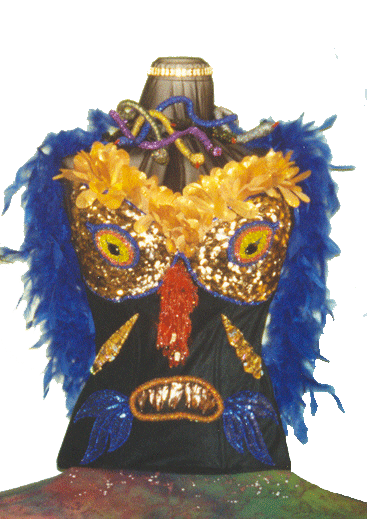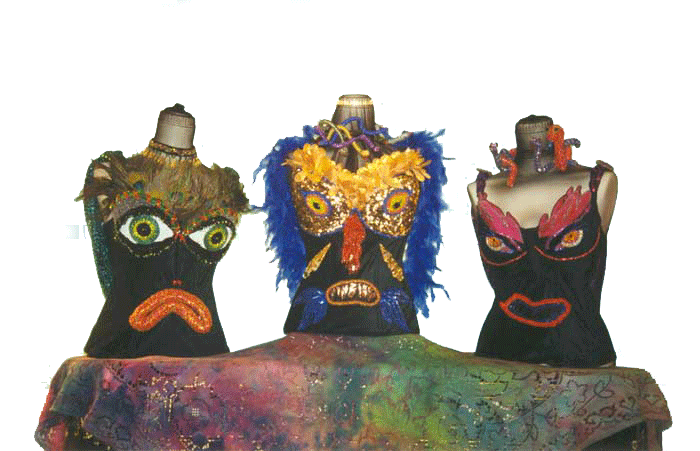|

 Artistic Collaboration
Results in a Multitude of Rewards
Artistic Collaboration
Results in a Multitude of Rewards
by Diane Fitzgerald
The image of the lonely bead artist laboring to create beadwork without the support or encouragement of a fellow artist, is all too often true. Beadart is time-consuming. Often it can take many months to produce a significant work, even for the fastest bead artist. Working in isolation, we often get in a rut and keep on producing the same or similar pieces.
As an antidote to this isolation, to stretch your artistic talents in a new direction and have some fun at the same time, try working with another bead artist -- a collaboration. A joint effort has many advantages: you may produce work that is larger and more impressive that either could do alone. Seeing your work through the eyes of a friendly collaborator will give you new insights on design and, importantly, color, a challenging aspect for all bead artists. In a collaboration, you have a willing ally to keep you going in those "slump" periods which inevitably occur.
Having been involved in several collaborations, I have found each rewarding in several ways. The first collaboration began with a class, "The Nymph's Green Glass Beads," at my shop, Beautiful Beads, in Minneapolis, Minnesota. Eight willing and experienced beadworkers registered for the class that grew into a special educational exhibit at the Minnesota State Fair. In the class we explored the poem by Harold Munro, "Overheard on a Saltmarsh," in which a goblin begs a nymph unsuccessfully for her green glass beads. The poem is rich in symbolism and offered many ideas for interpretation beyond the green glass beads. In one of the necklaces that resulted from the class, a clutching claw charm was used to symbolize the goblin's passion (and indeed, the passion many of us feel) for the beads which had been stolen from the moon. Another used a silver coil to show the ring the beads had been carried on. Everyone in the group enjoyed hearing the views of others as we read the poem and discussed our visual impressions and symbolic interpretations.
The second collaboration was instigated by viewing slides of the "Rebellious Bead" exhibit. Afterward, someone jokingly said, "Wouldn't it be fun to embellish a bra?" Although several liked the idea, the time and expense of the project was too great for some. The three who committed to the project, Valerie Harlow, Barbara McLean and myself were exhilarated by the idea and decided to try it.
At our first meeting to plan the project several questions were raised. What would this cost in both time and money? Why were we doing bras? How would we work together? Would we all work on one piece or would we each work on our own? Did we have a deadline? As we mulled over the questions, the project began to take shape.
After giving the idea of embellished bras more thought, we felt that embellishing a bra would simply be using it for sensationalism. There had to be a reason we were using a female form. The idea of female spirits arose and since there were three of us, I suggested the Three Furies from Greek mythology. These are female spirits who rise from the underworld to avenge evil deeds which escape human justice. Horrifying in their beauty, and often pictured with snakes for hair, the Furies gave us a theme which could tantalize our imaginations and result in striking pieces. We drew names to see who would do which of the three Furies: Alecto, Unceasing Rage; Tisiphone, Avenger of Murder; or Megaera, the Jealous One. We agreed to meet for a few hours every two weeks in early evening and began to take turns providing a light supper.
A first priority was research. Barb called upon her sister who did a library search. I went to the children's section of the library looking for illustrations and stories about the Furies. We found three black velvet bustiers (a long bra that extends to the hipline) at a local store on sale for $19.99 and snatched them up. (They fit us with slight alterations and the pieces can be worn.) To find a form to put the bustiers on both while working and for later showing, we went to a used store fixture outlet and found three matching blouse forms. We were off and running. The bra cups became the eyes. A mouth was added in the tummy area. Val added hot pink fabric eyelashes and Barb added peacock feathers for hair. I took apart a gold lame'
artifical flower and used the petals for hair. We began making snake necklaces to be worn with the bustiers.

Well underway by now, we began to think we had some chance of success and suggested that we find a venue for displaying the pieces. The Minnesota State Fair was still six months away and we felt we could finish them by that time. We worked easily together freely giving suggestions and ideas back and forth. Techniques that might have been jealously guarded were shared. Our color choices evolved into hot magenta for anger, teal green and red for jealousy and bright blue and gold for murder. Capes were added to give them greater presence. Reluctant to paint the blouse forms which were light flesh pink, we bought super-giant sheer black
panty hose and stretched it over the forms to reduce the brightness.
Throughout the long, cold Minnesota winter and well into spring we spent many hours working together and alone to finish the pieces, which became more and more elaborate as we worked. We finished a week before the deadline. (Sidebar A)
Excited, we filled out the entry forms for the Fine Arts exhibit and brought them in for jurying. As we set our treasures on the counter, the clerk's comment was, "Well, who copied whom on these?" This exhibit, it turned out, had no way to
accommodate a collaboration. Each entry had to be made by one individual. As a result we were competing against each other! The rejection notices came a few days later. (Personally, I was bummed out for two days.) Undaunted, Barb convinced Val and I to enter them in a second competition at the State Fair, the Creative Activities. Again we completed the forms and waited expectantly for the Fair to open. On opening day, Barb attended and called immediately to report that we had received not only a first place blue ribbon, but a purple sweepstakes ribbon for the highest award in the category. We were elated!
The third collaboration equally rewarding, but in a different way. Attending the Second Glass Beadmakers Conference in San Francisco, I became acquainted with Angela Green and her Trellis Rose Beads. The exquisite roses within her beads resemble miniaturized American Beauty Roses locked forever in the time capsule of a glass bead. Enamored with her work, I bought several and we began to correspond. She suggested that we do a collaboration. She would make two of her beads and I would design two identical necklaces using her beads, one for each of us. The idea appealed to me because I knew it would be difficult to do beadwork that would both set off her fantastic bead and yet would exemplify my artistry in beads as well.
Her bead arrived and sat on my desk for several months while I pondered various possibilities. After a few false starts, I decided to cover a half-inch diameter satin cord with black three-cut beads in a netted or lattice stitch. This black cord would continue the black core the rose was set against within the bead. This cord would then be embellished with tiny crystal chips spiraling up the cord to give sparkle and highlights. When Angela sent the first bead, a work of art made more wonderful by the
faceting of Robert Aurelius, she included a rose button. Somehow, I knew this would form the clasp for the necklace. (See Sidebar B for instructions.) Angela loved the necklace which showed her bead well. I photographed it and we later had a postcard printed. We both distribute this card, doubling our individual promotional efforts.
There are other ways to work in collaboration as well.
-A collaboration could start with a jar of beads and a single project of a free-form sculpture, vessel or piece of jewelry could travel from one person to the next.
-This method would also work well if you and your collaborator lived some distance apart. Write letters back and forth as you work to increase your ability to express what you are doing in words or with sketches. Be sure to agree up front where the piece will reside when it is finished. Or offer it as a raffle prize to benefit your bead society.
-Collaborations need not be long-term. In a one-day round-robbin collaboration each person would bring a pallette of beads and begin a piece of beadwork. It might be a peyote stitch pattern or it might be bead stringing, covering a vessel or whatever. After one hour, each person would pass their project and their beads to the next person. At the end of the day, you would have a piece unlike anything you could have done yourself and lots of new ideas as well.
-The round-robbin collaboration would also be work with each person using their own beads and in this way, the additional work would integrate a new selection of colors.
-A favorite group collaboration is one I learned from Helen Banes, with whom I co-authored the book, "Beads and Threads: A New Technique for Fiber Jewelry." In this project, a culture such as Egyptian, Pre-Columbian or Chinese is selected for study. Each person reads about the lifestyle, symbols, colors and materials used in a particular culture and interprets this in a necklace, vessel or other work.
-Another way to collaborate is to give each person the same packet of beads. Then, working alone, each individual creates whatever they wish. At an agreed-upon time, the group gets together and shows their pieces. There are sure to be many surprises with how different each piece will be.
So what insights can we gain from these experiences to help make our collaboration go well?
1. Define the project. Find or develop a theme or set limitations on what you will do. This means discuss the project thoroughly up front, but realize that as you work, new ideas may be presented. Limitations, the boundaries of what you will do in color, size or theme, help get you started and, rather than stunting your work, force you to think
creatively beyond what you would do ordinarily.
2. Set a deadline and agree on whether you will work alone or get together regularly. If working together, agree upon dates, time and location. It may be necessary to mail reminders if new meeting dates are arranged. If attendance is expected at each meeting, make this clear as well.
3. Ask each person to keep a diary of the collaboration and jot down notes about significant points such as frustrations or breakthroughs along the way.
4. Agree up front, if necessary on how much money will be spent on the project.
5. Get commitment to complete the project from everyone in the group. If it is necessary for someone to drop out, be clear about why so that the group can deal with this.
6. Finally, take time to discuss how the project is going. Putting your ideas into words makes them more concrete. Encourage everyone to make creative suggestions and to share techniques. Try to help stimulate a spirit of camaraderie and belonging which can carry over into future projects and result in lifetime friends.
© Diane Fitzgerald, Jewelry Crafts Magazine, Jan./Feb., 1997
|